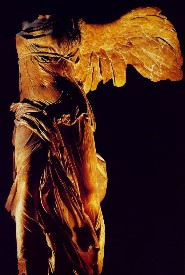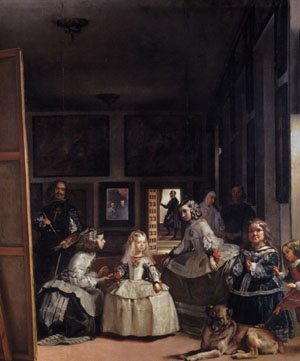 SIGNS OF SOME-THING ELSE / I
SIGNS OF SOME-THING ELSE / I

"A wind that blows from the abyss above us
among our brethren who one time existed
ripples and shakes the surface of our spirits,
and, reflected upon this trembling mirror,
the world, too, trembles."
--Miguel de Unamuno (1920)
[...]
NIGHTFALL / SOLSTICE
I.
At nightfall
I go behind closed doors,
Under red wine,
Under stars not there,
Before what remains
Missing, but blameless,
Slowly finding that
Which slips under
Sky and Sea,
Past radar under
Water, racing/pulsing
White light put out ...
II.
I reach Spanish lands,
Territories rare,
Red below veins
Of gold, streaks of silver,
Unfurled flags,
Stunning vistas,
Mountains soaked in
Wild subservience --
Conquered lands
Turning up on shores
Always darkening ...
GK (12/21/06)
 Image (right), The Most Famous Painting in the World? - Velázquez, 'Las Meninas' (1656) ... / Image (above), Winged Victory ...
Image (right), The Most Famous Painting in the World? - Velázquez, 'Las Meninas' (1656) ... / Image (above), Winged Victory ...POSTSCRIPT(S) / BIBLIOGRAPHIE / UPDATES
VELAZQUEZ - "It is perhaps the very greatest tour de force of western painting. In subject and execution, it is as the French philosopher Michel Foucault wrote in 1966, the representation of representation." Dawson W. Carr, "Painting and Reality: The Art and Life of Velázquez" [pp. 26-53], Dawson W. Carr, et alia, Velázquez (London: National Gallery of Art, 2006), p. 48 / See Estrella de Diego, "Representing Representation: Reading 'Las Meninas', Again" [pp. 150-169], in Suzanne L. Stratton-Pruitt (ed.), Velázquez’s 'Las Meninas' (Cambridge: Cambridge University Press, 2003) ...
TRUTH - "Truth is found behind appearances. And what is behind appearances is a great darkness. And it is that darkness that one will have to search for the truth." John Berger, "Los enanos cambian de sitio", in El retrato en el Museo del Prado (Madrid: Anaya, 1994), pp. 376-377, in Suzanne L. Stratton-Pruitt, "Velázquez’s ‘Las Meninas’" [pp. 124-149], in Suzanne L. Stratton-Pruitt (ed.), Ibid., p. 149 (trans. Suzanne L. Stratton-Pruitt) ...
"Signs of Something Else / II", Merciless (Soma)
"Signs of Something Else / III", Coda / The True (Soma)
CARAVAGGIO - "But Caravaggio (as he was called by everyone, with the name of his native town) was becoming more famous every day because the colouring he was introducing was not sweet and delicate as before, but became boldly dark and black, which he used abundantly to give relief to the forms. He went so far in this style that he never showed any of his figures in open daylight, but instead found a way to place them in the darkness of a closed room, placing a lamp high so that the light would fall straight down, revealing the principal part of the body and leaving the rest in shadow so as to produce a powerful contrast of light and dark." Giovanni Pietro Bellori, "Michelangelo da Caravaggio" [1672], Giorgio Mancini, Giovanni Baglione, Giovanni Pietro Bellori, Lives of Caravaggio (London: Pallas Athene, 2005), pp. 63-64 ... "Caravaggio’s style corresponded to his physiognomy and appearance; he had a dark complexion and dark eyes, and his eyebrows and hair were black; this colouring was naturally reflected in his paintings. His first style, sweet and pure in colour, was his best; he made great achievement in it and proved that he was a most excellent Lombard colourist. But afterward, driven by his own nature, he retreated to the dark style that is connected to his disturbed and contentious temperament." Ibid., p. 92 ...
PRADO - Santiago Alcolea (ed.), The Prado Museum (Barcelona: Poligrafa, 2002) - "Renowned as the largest art gallery in the world, the Prado houses sculptures, drawings, coins, and other works of art -- but it is its incomparable collection of paintings which has drawn fame worldwide. Included in its store of more than 8,600 paintings are works by members of the Italian, Flemish, Spanish, French, Dutch, and German schools. Albrecht Dürer, Anton van Dyck, Correggio, El Greco, Goya, Hieronymous Bosch, Jusepe de Ribera, Lucas Cranach, Nicolas Poussin, Pieter Brueghel, Rafael, Rembrandt, Rogier van der Veyden, Rubens, Sandro Botticelli, Tiepolo, Tintoretto, Tiziano, Velázquez, and nearly every other master painter from the 12th to the 20th century. The history of the Prado began during the reign of Charles III, when he tried to create a single collection under one roof, but it did not really concretize as an institution until the reign of Fernando VII, under whom the Royal Museum of Painting and Sculpture was founded in 1819. King Fernando's death caused inheritance problems and endangered the unity of the collection, but with the disappearance of the Spanish monarchy, the museum became national property and was renamed the Prado Museum. Only a tenth of the Prado's immense collection of works are normally on show at any one time in the museum's two buildings: the Villanueva and the Casón del Buen Retiro, but this will soon change. Architect Rafael Moneo has designed a plan to join the existing neo-classical building with two nearby historical buildings, the cloister of the San Jerónimo church and a 17th-century palace, by buried passageways, and has included a 400-seat underground auditorium as well. Completion of the project is scheduled for October 2003." - Cloth, 416 pages, ISBN 8-434-30962-9 / Museo Nacional del Prado (Madrid) ...
Velázquez @ the NGA (London), 18 October 2006 - 21 January 2007 ...
STRUTH - Thomas Struth @ Marian Goodman Gallery (New York), April 4–28, 2007 - "'Thomas Struth: Making Time' , currently on view at Museo Nacional del Prado, Madrid, includes eight of Struth’s earlier museum pictures installed in the Villanueva building of the Museo del Prado as well as six from the new Prado series. All the works will be shown at the Prado between April 27th and May 6th 2007. The works have been distributed within the celebrated galleries, alongside the permanent collection and placed in a direct dialogue with the historic masterworks of the museum. The museum pictures include Struth’s Self Portrait of Giles Robertson; Durer’s Self Portrait, Alte Pinakothek, Munich; Galleria dell Accademia I, Venice; and Delacroix’s Liberty Leading the People, photographed while at the Tokyo National Museum. The new works, Prado 8-1 – 8-5, Hermitage 1-7, and works from the Audience series will be on view in Rafael Moneo’s new wing of the museum, which will be inaugurated to the public at the end of April." (Marian Goodman) / The 'Catalogue': Estrella de Diego (ed.), Thomas Struth: Making Time (Madrid: Turner, 2007) - Paper, 116 pages, ISBN 8-475-06788-3 - For details, cliquez ici ... - For the German edition (Schirmer Mosel), cliquez ici (PDF) ...
PAROUSIA - Jean-Luc Nancy, Dis-Enclosure: The Deconstruction of Christianity, trans. by Bettina Bergo, Gabriel Malenfant, and Michael B. Smith (New York: Fordham University Press, 2007)


The Editors
 THE WAY OUT? - Levinas, Marion, Chrétien (SAMIZDAT)
THE WAY OUT? - Levinas, Marion, Chrétien (SAMIZDAT)